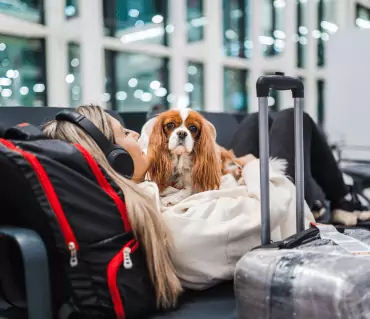Flying with Your Psychiatric Service Dog (PSD)



Discover & Navigate the Air Carrier Access Act (ACAA)
The Air Carrier Access Act (ACAA) protects the rights of passengers traveling with disabilities, including those who rely on service animals. Under the updated U.S. Department of Transportation (DOT) guidelines, airlines are required to recognize Psychiatric Service Dogs (PSDs) as service animals, ensuring they can travel in the cabin at no extra cost. To qualify, your PSD must be individually trained to perform tasks related to your mental health condition, and you’ll need to submit the DOT Service Animal Air Transportation Form to your airline before the flight.
While Emotional Support Animals (ESAs) are no longer recognized as service animals under the ACAA, they can still travel with you under most airlines’ pet travel policies. These policies vary by carrier and may include pet fees, approved carrier dimensions, and weight limits. At Wellness Wag, we guide you through these evolving regulations with clarity and care, helping you understand your rights, prepare proper documentation, and ensure a safe, stress-free experience for both you and your companion.
A New Chapter in Air Travel for PSD & ESA Owners
Since early 2021, major U.S. airlines have aligned with Department of Transportation(DOT)’s updated guidelines to ensure safe and comfortable travel for passengers and their animals.
Airlines are only legally required to recognize Service Animals, including Psychiatric Service Dogs (PSDs).
ESAs are now treated as pets by most airlines, meaning owners must follow each airline’s pet travel policy (fees, carrier rules, etc.).
However, some regional or international airlines may still allow ESAs under specific conditions. Wellness Wag keeps you informed about each airline’s most up-to-date requirements so you can choose the right option for your journey.


Fly Stress-Free with Your PSD
Traveling with your PSD doesn’t have to be complicated. With the right preparation and documentation, you can make every part of the journey smoother, from booking your ticket to boarding the plane. Start by confirming your airline’s current policy for Psychiatric Service Dogs (PSDs), and submit any required forms, like the DOT Service Animal Air Transportation Form, in advance.
On travel day, arrive early, keep your companion’s essentials (water, treats, harness, and carrier) easily accessible, and inform airline staff of your PSD during check-in. Small steps like these can make a big difference in ensuring a calm, comfortable experience for both you and your trusted companion.
























